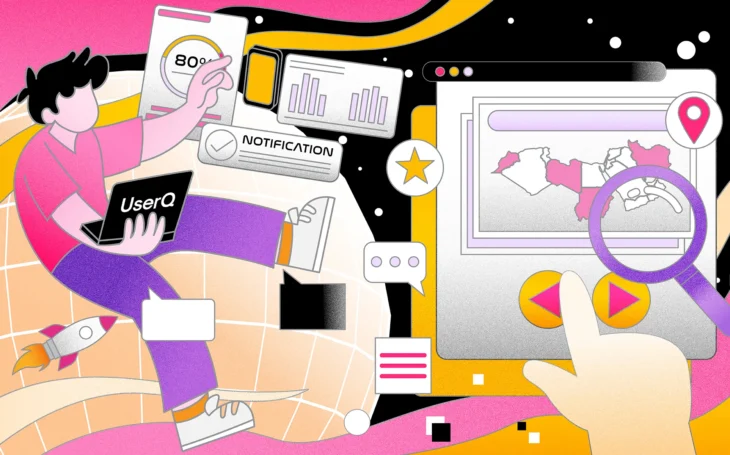🎁 Free 30-day publishing fees on Pay-As-You-GO. Get 15% off when recruiting from the UserQ Panel, with code HELLO15
Product development, User experience
Potential of AI in UX design: Shaping the future of user experience in MENA

With companies prioritising user-centric design to satisfy customer expectations, the Middle East and North Africa (MENA) area is a fast digital transformation. In this change, artificial intelligence (AI) is starting to be an effective tool for improving user experience (UX). The global AI in UX and UI design market is projected to grow at a CAGR of 24.8% from 2023 to 2030, reaching over $40 billion by 2030.
UX designers may develop more individualised and effective digital experiences by using AI’s capacity to examine data, forecast user behavior, and automate tasks.
AI's function in UX design
UX design now addresses user interaction and engagement with digital platforms rather than only the look of a website or app. AI improves user experience via:
- AI shapes design, layout, and content depending on user behavior.
- AI automates data-driven or repetitious operations, therefore lowering manual labor in design.
- Using user data, artificial intelligence generates proactive recommendations or modifications.
- Handling large databases and offering insights into user behavior that guide design decisions helps artificial intelligence improve data analytics.
For instance, tools such as Uizard.io and Galileo AI use AI to help create prototypes or designs based on prompts. Although these tools are more focused on design generation than directly measuring user behavior, they showcase how AI may help in many stages of UX design and research.
These AI technologies enable companies in the MENA area—where sectors including e-commerce, fintech, and telecoms are flourishing—to provide more seamless and customised customer experiences. The digital economy in the MENA region is expected to grow to $400 billion by 2030, with governments like the UAE and Saudi Arabia investing heavily in AI technologies.
AI in UX research
AI is revolutionizing UX research by automating tasks that were previously time-consuming and resource-intensive. AI tools help researchers acquire faster, more practical insights by analysing large datasets from quantitative and qualitative studies, as well as generating discussion guides.
- Writing discussion guides: AI tools can assist researchers in creating organized, targeted discussion guides by evaluating the research goals and recommending suitable topics.
- Data analysis and summarisation: Artificial intelligence can effectively process transcripts from user interviews and focus groups to find patterns, sentiment, and important themes. This enables faster analysis and synthesis of massive datasets while decreasing human error and subjectivity.
- Quantitative and qualitative insights: AI tools can swiftly process quantitative data from surveys and metrics, and also qualitative input from interviews, to provide real-time insights into consumer preferences and pain points.
These AI-powered skills may significantly accelerate the research and design phases in the MENA region, where sectors such as e-commerce and fintech are thriving, allowing businesses to create more user-centric digital experiences.
Personalising AI-powered devices
Personalization—which allows platforms to instantly adapt their interfaces based on user feedback—is one of AI’s most significant contributions to UX design. According to a study by Accenture, 91% of consumers are more likely to shop with brands that recognise, remember, and provide relevant offers and recommendations. Essential advantages of AI-driven personalisation include in:
- Hyper-personalization: Customizing experiences to individual preferences, such as language, currency, and product recommendations.
- Behavior analysis: Analyzing user interaction patterns to predict future behavior and suggest relevant features or content.
- Predictive design: Anticipating user needs based on previous behaviors and adjusting the interface proactively, offering suggestions or shortcuts before the user even knows they need them.
For example, artificial intelligence can enable a UAE e-commerce platform to change language choices and product offers according to customer location or browsing behavior. By using solutions like UserQ, companies can gather detailed user feedback, helping them understand their target audience better, including all the nuanced preferences and behaviors. This approach ensures that companies can create more tailored experiences that resonate with the local audience.
Prediction of user behavior and design optimisation
Artificial intelligence gives designers tools to forecast user behavior and maximise designs. AI can replace depending just on A/B testing and post-launch analytics with:
- Analyze real-time data: Examine real-time data on live websites to immediately spot user pain areas, navigation patterns, and engagement trends.
- Optimise layouts and content: Suggest design modifications to increase usability depending on user interactions by optimising layouts and content.
- Enhance user satisfaction: Continually improving the user journey helps foresee and stop problems before they start. In studies on AI-driven UX design, 67% of users reported a significant increase in satisfaction when interacting with platforms that used AI to personalise their experiences.
A financial app in Saudi Arabia, for example, can employ artificial intelligence to track user interactions, offering lessons for underused features or simplifying complex onboarding processes.
AI-Driven design automation
AI also helps designers save time by automating many facets of UX design, therefore freeing them to concentrate on strategic, creative work. Important domains in which artificial intelligence helps are:
- AI can provide pre-made designs depending on best standards and particular user data.
- AI can automatically test several design iterations, noting which performs better in real-time using A/B testing automation.
- Depending on user interaction data that might raise engagement, AI can recommend modifications to images, buttons, typefaces, or colors.
While this automation accelerates the design process and guarantees that UX decisions are data-driven, it’s vital to remember that AI’s current capabilities aren’t error-free. Sometimes the insights or ideas lack the subtle understanding of a human designer, resulting in errors in interpretation. However, as AI technologies advance, we can anticipate enormous improvements in accuracy and precision in the future years.
Real-time adaptation and conversational UX
Real-time adaption of digital interfaces made possible by artificial intelligence lets UX designs change as consumers use platforms. Here, two main trends are:
- Artificial intelligence can modify a website’s or app’s navigation, layout, or content based on real-time input. AI can, for instance, simplify a form or provide extra assistance if an Egyptian user is having trouble finishing one.
- Chatbots and virtual assistants driven by artificial intelligence offer natural language conversations, hence enhancing user involvement and support.
AI’s capacity to dynamically modify UX design is priceless in MENA, where cultural and technical diversity causes fast changes in user preferences.
AI’s potential to shape the future of UX in MENA
Artificial intelligence in UX design has excellent promise for MENA, especially as companies across industries seek to improve their digital services. The tech-savvy populace of the area and government-driven projects like Saudi Arabia’s Vision 2030 or the UAE’s AI Strategy are generating a climate fit for UX AI-led invention.
Key Patterns in MENA AI-Driven UX:
- Personalisation at scale: AI will let platforms provide millions of people from many linguistic and cultural backgrounds tailored experiences.
- Cross-device adaptability: AI-powered UX will provide flawless user experiences across several devices, from cellphones to smartwatches and beyond, therefore ensuring cross-device adaptability.
- Conversational interfaces: AI chatbots will develop to provide increasingly human-like interactions, hence enhancing customer service and engagement.
- Data-driven design: AI will progressively automate user data analysis, allowing faster iterations and optimisations for digital products.
Conclusion
As AI technology advances, the next several years will bring interesting improvements in UX design and research. We should expect AI to do increasingly better at analyzing user behavior, refining prediction models, and automating complicated design and research tasks. AI-powered solutions are anticipated to improve in areas such as emotion identification, personalised experiences, and real-time flexibility as user interactions evolve.
Furthermore, the integration of AI with augmented reality (AR) and virtual reality (VR) platforms promises to transform digital user experiences. These improvements will enable businesses to provide more immersive, engaging, and user-centered solutions, allowing them to stay ahead in the competitive digital market.
For businesses in the Middle East, embracing AI in UX design and research will be key to meeting the growing demand for tailored, seamless digital experiences. By staying at the forefront of these AI trends, companies can deliver innovative, intuitive, and future-ready products that exceed user expectations.
Related Post

The benefits of user research
User research is typically a key part of product development and business growth all around the world, but here at

Maximizing product managers’ ROI with
The importance of ROI for product managers Understanding remote user testing Remote user testing allows you to evaluate your product,

10 Warning signs of a
User experience (UX) design is critical in shaping the end-user’s interaction with digital solutions. As it plays a vital role
Subscribe to our
product newsletter!
Receive emails about UserQ updates, new features,
offers and latest trends.


